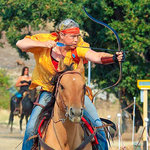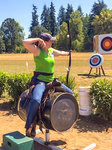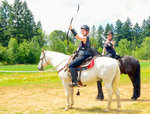


Mounted archery brings to mind Native Americans hunting buffalo on the broad grassy plains, or Mongolian warriors charging into battle on stout, sturdy ponies.
This 2,500-year-old martial art is seeing a modern resurgence worldwide, including right here in Brush Prairie.
Styles of mounted archery trace their origins to Korean, Hungarian and Persian culture. The sport blends horsemanship with archery skills as competitors gallop through a 90-meter course while loosing arrows at various targets.
Volcano Ridge Mounted Archers (VRMA) is a club of mounted archery enthusiasts based at Arrowhead Acres in Brush Prairie. The multi-faceted organization offers training and practices at their archery range, participates in public exhibitions, competition in mounted archery contests, provides youth scholarships for mounted archery, and operates a rescue horse training program.
The group was incorporated as a nonprofit 501(c)(3) this year, and already logs 52 active members. It is an affiliate of The Mounted Archery Association of the Americas (MA3), the national organization for the sport, which offers an umbrella for mounted archery clubs across the country.
Ridgefield resident Susie Castle is a board member and founding member of VRMA. Castle is a lifelong equestrian and has ridden in many disciplines, but she is especially enthusiastic about mounted archery.
As challenging as it appears to be, she has not found the sport especially difficult.
“I did archery as a kid,” said Castle. “It’s just bringing back the muscle memory.”
Additionally, she has done strength training to stabilize an injured rotator cuff in her shoulder, which would otherwise be strained by the use of the bow and arrow.
Aiming accurately is one of the biggest challenges for Castle, since she experiences double vision due to a previous head injury. But, she said, it seems easier to take aim from a galloping horse than a stationary position; perhaps the playing field is leveled compared to other riders.
“It’s new, it’s exciting. It’s kind of barbaric,” she laughed.
She loves releasing the reins on a galloping horse to take aim.
“It’s freedom, the feeling you’re just going. It brings back the feeling you had as a child, you come back to that feeling,” she said.
Members of VRMA have access to training facilities at Arrowhead Acres and the group practices twice weekly, weather permitting. New members must be a member of MA3, complete a skills assessment, and pay an annual membership fee.
Practices focus on safety first, asserted Castle. Youth begin learning to shoot from horseback while on a leadline, and all riders practice from an “iron horse,” a horse figure towed behind an ATV.
“There’s a lot of ground shooting and training before horseback,” said Castle.
Each horse is assessed as well, to assure it has the basic level of training and disposition suited to the sport.
Ultimately, the rider will drop the reins and the horse will charge straight down a lane at a full gallop, while the archer takes aim at a target.
VRMA supports horses and riders along with providing a training ground for mounted archers. The Horse Rescue Program fosters two rescue horses each year and provides rehabilitation and training to prepare them for a job as archery mounts.
In addition, the group funds scholarships for two youth members, which provide them with access to facilities, training, competition, and a horse to ride if needed.
VRMA participates in the U.S. Veterans Corps Mounted Color Guard to provide horses and riders for memorial events, and they have partnered with the Warrior Within program to offer equine-assisted activities for veterans.
A two-tour veteran described her experience when she joined the archery group.
“I don’t know what this is,” she said, “but other veterans need to do it.”
“You have this bond with your horse,” said Castle. “It’s a healing feeling that you get when you can trust your horse.”